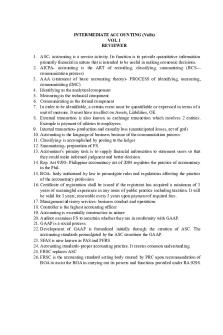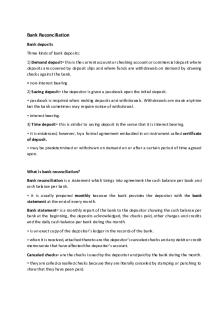Revaluation-Model - intermediate accounting 1 PDF

| Title | Revaluation-Model - intermediate accounting 1 |
|---|---|
| Author | Hannah Hanor |
| Course | BS Accountancy |
| Institution | Mindanao State University |
| Pages | 3 |
| File Size | 61.9 KB |
| File Type | |
| Total Downloads | 394 |
| Total Views | 461 |
Summary
REVALUATION MODEL Revaluation Model – after recognition as an asset, an item of PPE whose FV can be measured reliably shall be carried at a revalued amount, being its FV at date of revaluation, less any subsequent accumulated depreciation and accumulated impairment losses. Guidelines in Revaluation ...
Description
REVALUATION MODEL 1. Revaluation Model – after recognition as an asset, an item of PPE whose FV can be measured reliably shall be carried at a revalued amount, being its FV at date of revaluation, less any subsequent accumulated depreciation and accumulated impairment losses. 2. Guidelines in Revaluation A. Basis for Revaluation – the revalued amount of the PPE is based on one of the following: Fair Value (Appraised Value) – for land and buildings market based evidence by appraisal that is normally undertaken by professionally qualified valuers Depreciated Replacement Cost (Sound Value) – if there is no market based evidence of FV because of the specialized nature of the item of PPE and the item is rarely sold, an entity may need to estimate FV using a depreciated replacement cost approach B. Revaluation Applied to All Items in a Class – when an item of PPE is revalued, the entire class of PPE to which that asset belongs should be revalued A class of PPE is a grouping of assets of a similar nature and use in an enterprises operations This is done in order to avoid selective revaluation of assets and the reporting of amounts which are a mixture of costs and values at different dates However, a class of assets may be revalued on a rolling basis provided revaluation of the class of assets is completed within a short period of time and provided the revaluations are kept up to date. C. Frequency of Revaluation – depends on the movements in the FV of the items of PPE being revalued; when the FV of a revalued asset differs materially from its CA, a further revaluation is necessary. With significant and volatile annual revaluation movements in fair value With only insignificant it depends; normally 3 to 5 years movements in fair value 3. Formula for Revaluation Cost xx (xx) xx
Asset Accumulated Dep’n CA/SV/RS
Asset Residual Value Depreciable Amount Accumulated Dep’n Rem. Depreciable Amount
Rem. Useful Life Annual Dep’n
÷
Cost xx (xx)c xx (xx) xx xx xx
Replacement Cost xx (xx)a xxb
Replacement Cost xx (xx)c xx (xx)a xxb xxd xx
Appreciation xx (xx) xx
Appreciation xx (xx) xx (xx) xx xx xx
a
= Replacement Cost × (Accum Dep’n Cost / Depreciable Amt Cost) = if FV is available, no need to depreciate it as it represents the SV of the asset already c = if there is a change in RV, use the revised RV in the formula above even if for cost; however, the original RV must be considered in computing Accumulated Dep’n based on cost d = or revised useful life if there was revision
b
Definition of Terms Revaluation – consists of the following steps: a. Preparation of a detailed listing of the items of PPE at appraisal date b. Detailed inspection of each unit of property c. Pricing of the property items ordinarily at FV or replacement cost d. Determination of accumulated depreciation e. Calculation of the depreciated replacement cost of the property by professionally
qualified valuers
Depreciated Replacement Cost – replacement cost of the property (current purchase price) less observed depreciation Revaluation Surplus/Increment – FV or sound value of the asset less the CA of the PPE (net appreciation) Appreciation – excess of the revalued amount over the historical cost 4. Recording the Revaluation – when an item of PPE is revalued, any accumulated dep’n at the date of revaluation is treated in one of the following ways: A. Proportional Method B. Elimination Method xxa
Asset
Accum Dep’n
Accumulated Dep’n
xx b
R/S
xx
xx c
Asset
xx
Asset
xx R/S
xx
a
– Amount of depreciation – Corresponding accum dep’n (observed depreciation) c – Accumulated balance as of revaluation date b
Statement Presentation – the asset is presented in the SFP at the revalued amount less subsequent A/D and A/I; the historical cost and related A/D shall be disclosed in the NTFS. Treatment of Revaluation On the date of revaluation a. Increase
Recognize in P/L the increase that represents reversal of previously recognized impairment loss; excess is credited to R/S (part of OCI) Recognize in P/L the decrease which represents an impairment loss
b. Decrease
On the date of revaluation
Any amount credited to R/S shall be transferred directly to R/E when surplus is realized.
Sale/retirement/disposal
Whole surplus (100%)
Through continuing use
Over the rem. Useful life of the asset; consider life revision if any.
realized
5. Reversal of Revaluation Increase/Decrease
Increase reversal
1. Any R/S to the extent that the decrease is a reversal of a previous revaluation (presented as OCI – loss) 2. Recognized as impairment loss (P/L)
Decrease reversal
1. Gain/Income to the extent that it reverses a revaluation decrease of the same asset previously recognized as an expense 2. Revaluation Surplus...
Similar Free PDFs

PPE - intermediate accounting 1
- 7 Pages

Intacc 1 INTERMEDIATE ACCOUNTING
- 5 Pages

Intermediate- Accounting
- 6 Pages

Intermediate accounting
- 3 Pages

Intermediate accounting
- 84 Pages

Intermediate Accounting
- 7 Pages

Intermediate Accounting
- 12 Pages

Pdf - Intermediate accounting
- 23 Pages

Reviewer for Intermediate Accounting
- 106 Pages

Intermediate Accounting Reviewer
- 5 Pages

Intermediate Accounting PPE REVALS
- 24 Pages
Popular Institutions
- Tinajero National High School - Annex
- Politeknik Caltex Riau
- Yokohama City University
- SGT University
- University of Al-Qadisiyah
- Divine Word College of Vigan
- Techniek College Rotterdam
- Universidade de Santiago
- Universiti Teknologi MARA Cawangan Johor Kampus Pasir Gudang
- Poltekkes Kemenkes Yogyakarta
- Baguio City National High School
- Colegio san marcos
- preparatoria uno
- Centro de Bachillerato Tecnológico Industrial y de Servicios No. 107
- Dalian Maritime University
- Quang Trung Secondary School
- Colegio Tecnológico en Informática
- Corporación Regional de Educación Superior
- Grupo CEDVA
- Dar Al Uloom University
- Centro de Estudios Preuniversitarios de la Universidad Nacional de Ingeniería
- 上智大学
- Aakash International School, Nuna Majara
- San Felipe Neri Catholic School
- Kang Chiao International School - New Taipei City
- Misamis Occidental National High School
- Institución Educativa Escuela Normal Juan Ladrilleros
- Kolehiyo ng Pantukan
- Batanes State College
- Instituto Continental
- Sekolah Menengah Kejuruan Kesehatan Kaltara (Tarakan)
- Colegio de La Inmaculada Concepcion - Cebu




